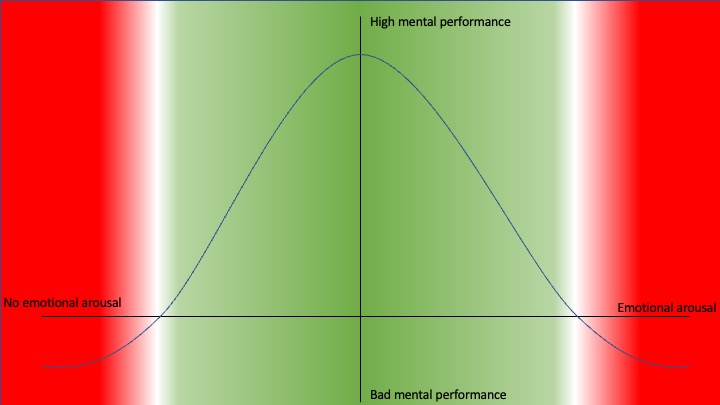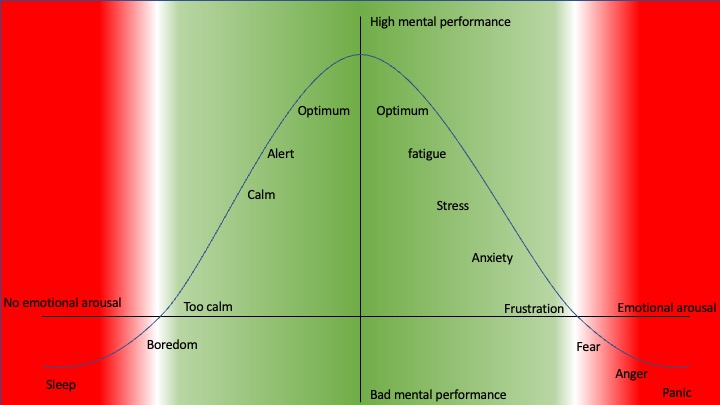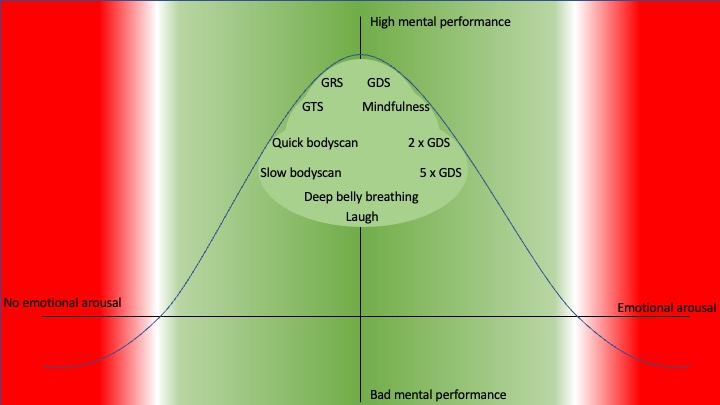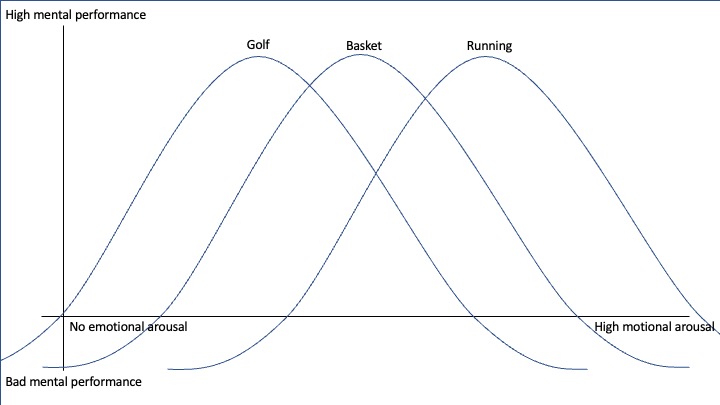You see it on the golf cause again and again. Many golfers have a hard time controlling their emotions. First, they get too anxious before the golf shot because they fear the result and mis it just because of that. Then they get frustrated because of the bad result. Some even take this into a vicious circle.
Others don’t show but do it anyway.
The Yerkes-Dodson’s first law came about in 1908 when the two psychologists Robert Yerkes and John Dillingham Dodson found that increased arousal helps improve performance up to a certain optimal point. After the optimal arousal point where arousal becomes excessive performance falls again. Please find below illustration 18.1. which shows emotional arousal as a function of high mental performance.
18.1. Illustration: Yerkes-Dodson’s first law, Mental performance vs. Emotional arousal

18.2. Illustration: Mental golf performance spelled out vs. Emotional arousal

Source: Yerkes-Dodson
Illustration 18.2. shows what mental arousal does to your performance. You will see that too little arousal does not get you to the top of your mental golf performance. You need to be aroused enough to be alert and you cannot be too calm. Sleeping during a round of golf is obviously not the way to get good results. Same thing is true for frustration, fear, and anger. Those mental states are not getting you anywhere in golf.
The optimal golfing performance comes when you are alert, calm, collected and focused but if you concentrate too much during a round of golf you can also become tired and lose your ability to concentrate.
18.3. Illustration: Mental states of your choice vs. mental golf performance

Source: Yerkes-Dodson & Neuro Linguistic Programming, NLP
Illustration 18.3 shows which mental states you can pick from and enter when you are in a competitive situation where you want to perform at your best. You need to be at you best to perform at your best. This brings us to the question: “which state is the best?”
You need to find this answer by knowing and using all nine states above while playing golf. In that way you will find out which state is the best for your own best performance. GDS (General Desired State) should really be the answer because GDS originates from a situation where you performed at your best. Golf however is a funny old game that tricks our minds in peculiar ways. Consequently, we can get too tense, and we need to cool down, which means GRS might come in handy. All in all, you need to know the techniques to pick the right one and use it when you need it.
I once coached a young man. We were 6 people taking a short coaching round and we had a good chat about each stroke. There was no competition whatsoever. But of cause, this is golf and competition never leave golf 100%. There will always be a bit of competition when you hit a golf ball. The young man had a good drive, and his second shot was a relatively simply approach shot. The trouble with this approach shot was that 5 people were watching him when he was doing his swing. He hit the ground, made a tremendous turf, and then hit the ball. The ball went into the water which wasn’t even in play. It was an awful golf shot. I ask him what happened. He told me that having 5 people watching him made him nervous. He also mentioned that he concentrated on the 5 people and not the ball. I ask him to do his pre shot routine which of cause includes a GDS. His next shot ended up next to the pin. I have never seen such a beautiful smile on a face.
18.4. Illustration: Yerkes-Dodson’s second law

Source: Yerkes-Dodson
Yerkes-Dodson’s second Law tells us that for sports demanding high level of attention, deduction, reaction, choice of action and very precise movements, the optimal level of emotional arousal is relatively low. On the contrary sports with relatively simple skills but demanding strength and speed, the optimal level of arousal is high. Here are a couple of examples:
Some sports demand high level of technical skills and mental concentration. Golf is one of them. Other sports are shooting, archery, golf, billiards, figure skating, penalty shooting, etc. You do not need your maximum strength to perform in these sports, but you do need your maximum mental focus and any distraction will destroy your performance. Consequently, low level of arousal will help you to be calm, collected, and focused and therefore to perform at your best.
Sports with less technical skills involved are fencing, Basket, tennis, badminton, volleyball, etc.
Sports with high level of strength and low level of technical skills such as running, weightlifting, rugby, boxing, hockey, etc. There is of cause technical skills involved in theses sports, but the level of strength required to perform is prevailing. Consequently, higher mental arousal is needed to generate the highest mental performance. In fact, Yerkes-Dodson’s second law is sometimes illustrated and shown so higher arousal leads to higher performance. An example is running where you may argue that the fastest runner might be the one who is in mental state of panic and fear. You can find the law and the illustration and see the details if you google Yerkes-Dodson’s second law.
18.1 High level of confidence and the comfort zone
You have a high level of confidence when you are in your Comfort zone and a low level of confidence when you are outside your comfort zone. If you agree to this statement, why not make sure you are in the comfort zone as much as possible?
If you want to get into your comfort zone, you need to get into your routines. Meaning, your pre-shot routine, Post-Shot routine, Between-Shots routine, and wait routine. At the same time do not forget to get into the mental state that suits the purpose just mentioned in the according chapters above.
